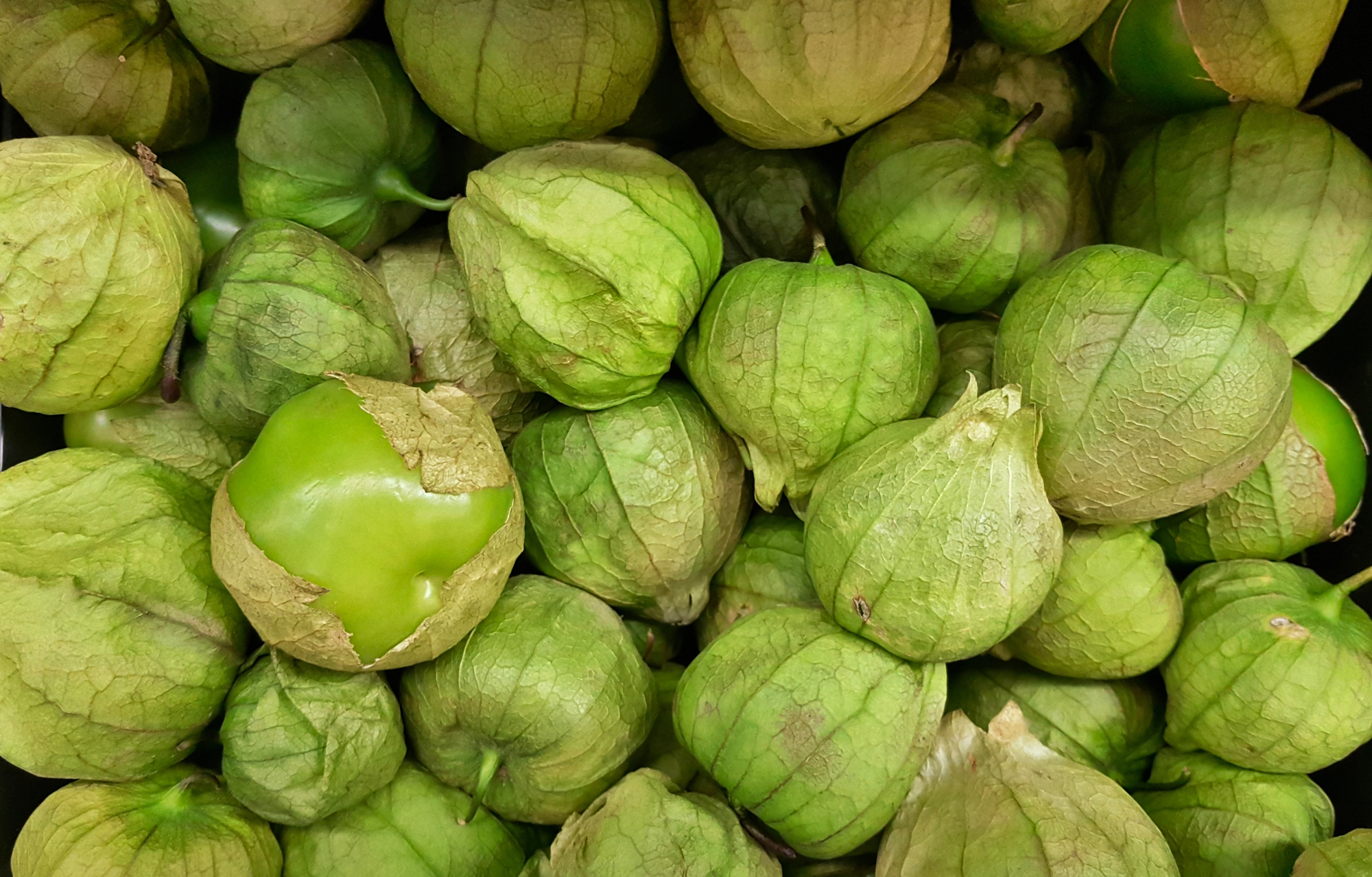Tomatillo Donation Tracker
Quick Links: How & Where to Grow | Temperature | How to Care For | Harvest Signs | Harvesting | Pruning | Pests | Companions | Preservation | Recipes | Michigan Tips | Fun Facts
🌱 How & Where to Grow Tomatillos:
- Start 6-8 weeks before frost indoors.
- Need 2+ plants for pollination – this is crucial for fruit set!
- Space 3 feet apart – they sprawl more than tomatoes.
- Sunlight: Full sun (6-8 hours) for best production.
- Soil Type: Well-drained soil with pH 6.0-7.0, tolerates poor soil.
- Soil Amendment: Moderate compost – too rich soil produces leaves over fruit
Unlike tomatoes, tomatillos MUST have a pollination partner – always grow at least two plants!
🌡️ Temperature Guidance:
Minimum 65°F soil. More cold-sensitive than tomatoes.
- Transplanting: Wait until soil is reliably 65°F+ and nights stay above 55°F.
- Growing: Thrives in 70-85°F temperatures.
- Will not set fruit if nights drop below 60°F.
- More heat-tolerant than tomatoes once established.
In SE Michigan, wait until early June to transplant – they can’t handle our cool spring nights!
💧 How to Care for:
- Consistent Moisture: Important during fruit development.
- Watering: 1-2 inches weekly, less than tomatoes need.
- Support: Cage or stake – sprawling plants produce less.
- Mulch: 2-3 inches to suppress weeds and retain moisture.
- Fertilizer: Light feeding – too much nitrogen reduces fruiting.
📏 Harvest Signs:
Husk splits and browns. Fruit fills husk. 75-100 days from transplant.
- The husk tells you everything – when it splits, check the fruit!
- Fruit should fill the husk completely when ripe.
- Color changes from green to yellow-green at full ripeness.
- Fruit easily detaches from plant when ready.
Don’t wait too long – overripe tomatillos become yellow and lose their signature tartness!
🧺 Harvesting:
Remove husk before use. Wash off sticky coating. Harvest regularly.
- Always harvest into containers – fruits drop easily when ripe.
- Peel off papery husk to reveal sticky fruit.
- Wash thoroughly to remove sticky residue before use.
- Pick every few days to encourage continued production.
- Green fruits are most desirable for traditional Mexican dishes.
✂️ Pruning:
Light pruning for airflow. Remove ground-touching branches. Optional sucker removal.
- Less critical than tomatoes – tomatillos naturally sprawl and fruit well.
- Remove lower branches that touch the ground to prevent disease.
- Thin center if growth is very dense to improve airflow.
- Optional: Remove some suckers to control size in small gardens.
- Late season: Top plants 4 weeks before frost to ripen existing fruit.
🪲 Michigan Pests:
Generally disease resistant. Flea beetles, blight possible.
- Remarkably pest-free compared to tomatoes – a huge advantage!
- Flea beetles may attack young plants – use row covers.
- Tomato hornworms occasionally visit but prefer tomatoes.
- Late blight can affect in very wet years.
🫱🏽🫲🏼 Companions:
Tomatoes, peppers, corn, beans, marigolds.
- Other nightshades share similar growing needs.
- Corn provides light shade in hot summers.
- Beans fix nitrogen for heavy-feeding tomatillos.
- Marigolds deter pests as with tomatoes.
- Basil may improve growth and flavor.
🫙 Preservation:
Store in husks 1 month. Freeze whole. Can salsa verde.
- Fresh storage: Leave husks on, store in mesh bag in refrigerator up to 1 month.
- Freezing: Remove husks, wash, freeze whole on trays then bag.
- Canning: Only in tested salsa verde recipes with proper acid.
- Roasting and freezing: Roast first for deeper flavor.
- Dehydrating: Slice and dry for unique seasoning.
🧑🏽🍳 Recipes:
Authentic salsa verde, green enchilada sauce, tomatillo gazpacho.
- Classic salsa verde – roast tomatillos with jalapeños and garlic.
- Green pozole soup showcases their bright acidity.
- Raw tomatillo salsa (salsa cruda) for fish tacos.
- Tomatillo jam pairs wonderfully with cheese.
- Green shakshuka for a Mexican twist on the classic.
✋🏼 Michigan Tips:
- Wait until June to transplant – they need warm soil.
- Grow in containers to move during cold snaps.
- Plant near south-facing walls for extra heat.
- Use black plastic mulch to warm soil faster.
- Choose early varieties when available.
- Start seeds earlier indoors (8-10 weeks) for longer production.
🧠 Fun Facts:
- “Little tomato” in Spanish.
- Aztecs grew before tomatoes.
- Tomatillos date back to 800 B.C. in Mexico – predating tomato cultivation!
- Also called “Mexican husk tomatoes” or “jamberries.”
- The sticky coating on fruits is completely natural and edible.
- Purple and yellow varieties exist but green is traditional.
- Wild tomatillos still grow throughout Central America.
- Essential ingredient in authentic Mexican cuisine – not replaceable with green tomatoes!


0 Comments